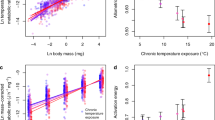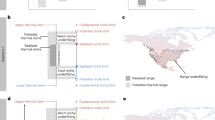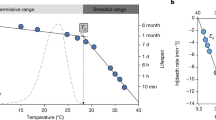Abstract
Documented shifts in geographical ranges1,2, seasonal phenology3,4, community interactions5, genetics3,6 and extinctions7 have been attributed to recent global warming8,9,10. Many such biotic shifts have been detected at mid- to high latitudes in the Northern Hemisphere4,9,10—a latitudinal pattern that is expected4,8,10,11 because warming is fastest in these regions8. In contrast, shifts in tropical regions are expected to be less marked4,8,10,11 because warming is less pronounced there8. However, biotic impacts of warming are mediated through physiology, and metabolic rate, which is a fundamental measure of physiological activity and ecological impact, increases exponentially rather than linearly with temperature in ectotherms12. Therefore, tropical ectotherms (with warm baseline temperatures) should experience larger absolute shifts in metabolic rate than the magnitude of tropical temperature change itself would suggest, but the impact of climate warming on metabolic rate has never been quantified on a global scale. Here we show that estimated changes in terrestrial metabolic rates in the tropics are large, are equivalent in magnitude to those in the north temperate-zone regions, and are in fact far greater than those in the Arctic, even though tropical temperature change has been relatively small. Because of temperature’s nonlinear effects on metabolism, tropical organisms, which constitute much of Earth’s biodiversity, should be profoundly affected by recent and projected climate warming2,13,14.
This is a preview of subscription content, access via your institution
Access options
Subscribe to this journal
Receive 51 print issues and online access
$199.00 per year
only $3.90 per issue
Buy this article
- Purchase on Springer Link
- Instant access to full article PDF
Prices may be subject to local taxes which are calculated during checkout


Similar content being viewed by others
References
Parmesan, C. & Yohe, G. A globally coherent fingerprint of climate change impacts across natural systems. Nature 421, 37–42 (2003)
Colwell, R. K., Brehm, G., Cardelus, C. L., Gilman, A. C. & Longino, J. T. Global warming, elevational range shifts, and lowland biotic attrition in the wet tropics. Science 322, 258–261 (2008)
Bradshaw, W. & Holzapfel, C. Genetic shift in photoperiodic response correlated with global warming. Proc. Natl Acad. Sci. USA 98, 14509–14511 (2001)
Parmesan, C. Influences of species, latitudes and methodologies on estimates of phenological response to global warming. Glob. Change Biol. 13, 1860–1872 (2007)
Both, C., van Asch, M., Bijlsma, R., van den Burg, A. & Visser, M. Climate change and unequal phenological changes across four trophic levels: constraints or adaptations? J. Anim. Ecol. 78, 73–83 (2009)
Umina, P. A., Weeks, A. R., Kearney, M. R., McKechnie, S. W. & Hoffmann, A. A. A rapid shift in a classic clinal pattern in Drosophila reflecting climate change. Science 308, 691–693 (2005)
Sinervo, B. et al. Erosion of lizard diversity by climate change and altered thermal niches. Science 328, 894–899 (2010)
IPCC. Climate Change 2007: Impacts, Adaptation, and Vulnerability (Cambridge Univ. Press, 2007)
Walther, G.-R. et al. Ecological responses to recent climate change. Nature 416, 389–395 (2002)
Rosenzweig, C. et al. Attributing physical and biological impacts to anthropogenic climate change. Nature 453, 353–357 (2008)
Root, T. L. et al. Fingerprints of global warming on wild animals and plants. Nature 421, 57–60 (2003)
Gillooly, J. F., Brown, J. H., West, G. B., Savage, V. M. & Charnov, E. L. Effects of size and temperature on metabolic rate. Science 293, 2248–2251 (2001)
Deutsch, C. A. et al. Impacts of climate warming on terrestrial ectotherms across latitude. Proc. Natl Acad. Sci. USA 105, 6668–6672 (2008)
Pounds, J., Fogden, M. & Campbell, J. Biological response to climate change on a tropical mountain. Nature 398, 611–615 (1999)
Savage, V. M. Improved approximations to scaling relationships for species, populations, and ecosystems across latitudinal and elevational gradients. J. Theor. Biol. 227, 525–534 (2004)
Clarke, A. Temperature and the metabolic theory of ecology. Funct. Ecol. 20, 405–412 (2006)
Downs, C. J., Hayes, J. P. & Tracy, C. R. Scaling metabolic rate with body mass and inverse body temperature: a test of the Arrhenius fractal supply model. Funct. Ecol. 22, 239–244 (2008)
O’Connor, M. P. et al. Reconsidering the mechanistic basis of the metabolic theory of ecology. Oikos 116, 1058–1072 (2007)
Martínez del Rio, C. Metabolic theory or metabolic models? Trends Ecol. Evol. 23, 256–260 (2008)
Lott, N., Baldwin, R. & Jones, P. The FCC Integrated Surface Hourly Database, A New Resource of Global Climate Data. 〈http://www1.ncdc.noaa.gov/pub/data/techrpts/tr200101/tr2001-01.pdf〉 (National Climatic Data Center, 2001)
Rice, W. R. & Gaines, S. D. Extending non-directional heterogeneity tests to evaluate simply ordered alternative hypotheses. Proc. Natl Acad. Sci. USA 91, 225–226 (1994)
Dunham, A. E. in Biotic Interactions and Global Change (eds Kareiva, P. M., Kingsolver, J. G. & Huey, R. B.) 95–119 (Sinauer, 1993)
Hertz, P. E., Huey, R. B. & Stevenson, R. D. Evaluating temperature regulation by field-active ectotherms: the fallacy of the inappropriate question. Am. Nat. 142, 796–818 (1993)
Kearney, M., Shine, R. & Porter, W. P. The potential for behavioral thermoregulation to buffer “cold-blooded” animals against climate warming. Proc. Natl Acad. Sci. USA 106, 3835–3840 (2009)
Pörtner, H. Physiological basis of temperature-dependent biogeography: tradeoffs in muscle design and performance in polar ectotherms. J. Exp. Biol. 205, 2217–2230 (2002)
Irlich, U. M., Terblanche, J. S., Blackburn, T. M. & Chown, S. L. Insect rate–temperature relationships: environmental variation and the metabolic theory of ecology. Am. Nat. 174, 819–835 (2009)
Wake, D. B. & Vredenburg, V. T. Are we in the midst of the sixth mass extinction? A view from the world of amphibians. Proc. Natl Acad. Sci. USA 105, 11466–11473 (2008)
Bond-Lamberty, B. & Thomson, A. Temperature-associated increases in the global soil respiration record. Nature 464, 579–582 (2010)
Paaijmans, K. P., Read, A. F. & Thomas, M. B. Understanding the link between malaria risk and climate. Proc. Natl Acad. Sci. USA 106, 13844–13849 (2009)
Hastings, D. A. & Dunbar, P. K. Global Land One-Kilometer Base Elevation (GLOBE). 〈http://www.ngdc.noaa.gov/mgg/topo/report/globedocumentationmanual.pdf〉 (National Geophysical Data Center, 1999)
Reich, P. B., Tjoelker, M. G., Machado, J.-L. & Oleksyn, J. Universal scaling of respiratory metabolism, size and nitrogen in plants. Nature 439, 457–461 (2006)
Ruel, J. J. & Ayres, M. P. Jensen’s inequality predicts effects of environmental variation. Trends Ecol. Evol. 14, 361–366 (1999)
Acknowledgements
We thank T. L. Daniel, C. Martínez del Rio, W. R. Rice and J. Tewksbury for discussion, and S. L. Chown for sharing his data on latitudinal variation in E. Research was funded in part by NSF IOB-041684 to R.B.H. and by an NSF Minority Postdoctoral Fellowship to M.E.D.
Author information
Authors and Affiliations
Contributions
M.E.D., G.W. and R.B.H. conceived the project, designed the analyses and wrote the paper; M.E.D. and G.W. collated weather station data and did temperature and metabolic rate calculations.
Corresponding author
Ethics declarations
Competing interests
The authors declare no competing financial interests.
Supplementary information
Supplementary Information
The file contains Supplementary Tables 1-2 and Supplementary Figures 1-5 with legends. (PDF 422 kb)
PowerPoint slides
Rights and permissions
About this article
Cite this article
Dillon, M., Wang, G. & Huey, R. Global metabolic impacts of recent climate warming. Nature 467, 704–706 (2010). https://doi.org/10.1038/nature09407
Received:
Accepted:
Published:
Issue Date:
DOI: https://doi.org/10.1038/nature09407
This article is cited by
-
Predicting movement speed of beetles from body size and temperature
Movement Ecology (2023)
-
Protected areas slow declines unevenly across the tetrapod tree of life
Nature (2023)
-
Future temperature extremes threaten land vertebrates
Nature (2023)
-
Climate warming drives a temperate-zone lizard to its upper thermal limits, restricting activity, and increasing energetic costs
Scientific Reports (2023)
-
Future heatwaves threaten thousands of land vertebrate species
Nature (2023)
Comments
By submitting a comment you agree to abide by our Terms and Community Guidelines. If you find something abusive or that does not comply with our terms or guidelines please flag it as inappropriate.



